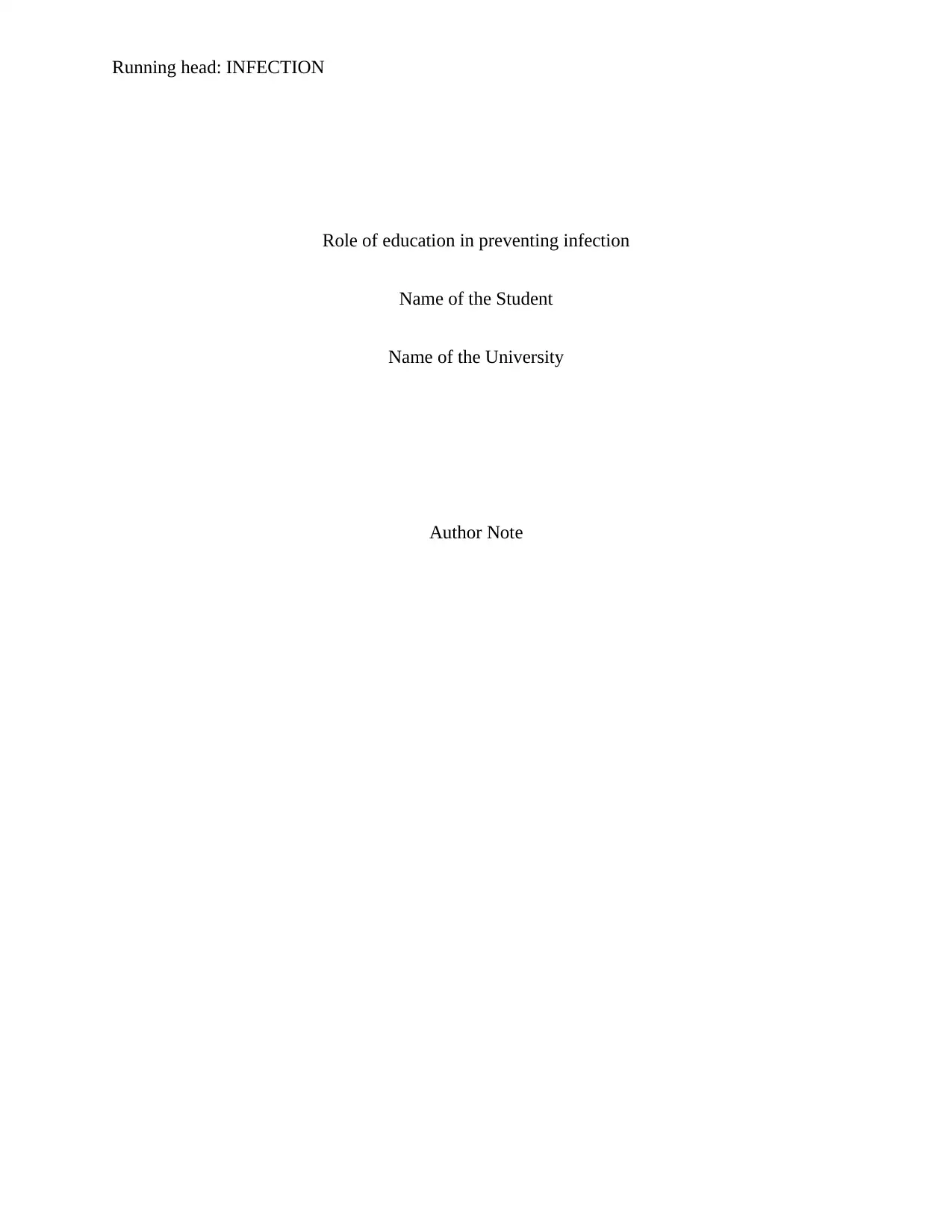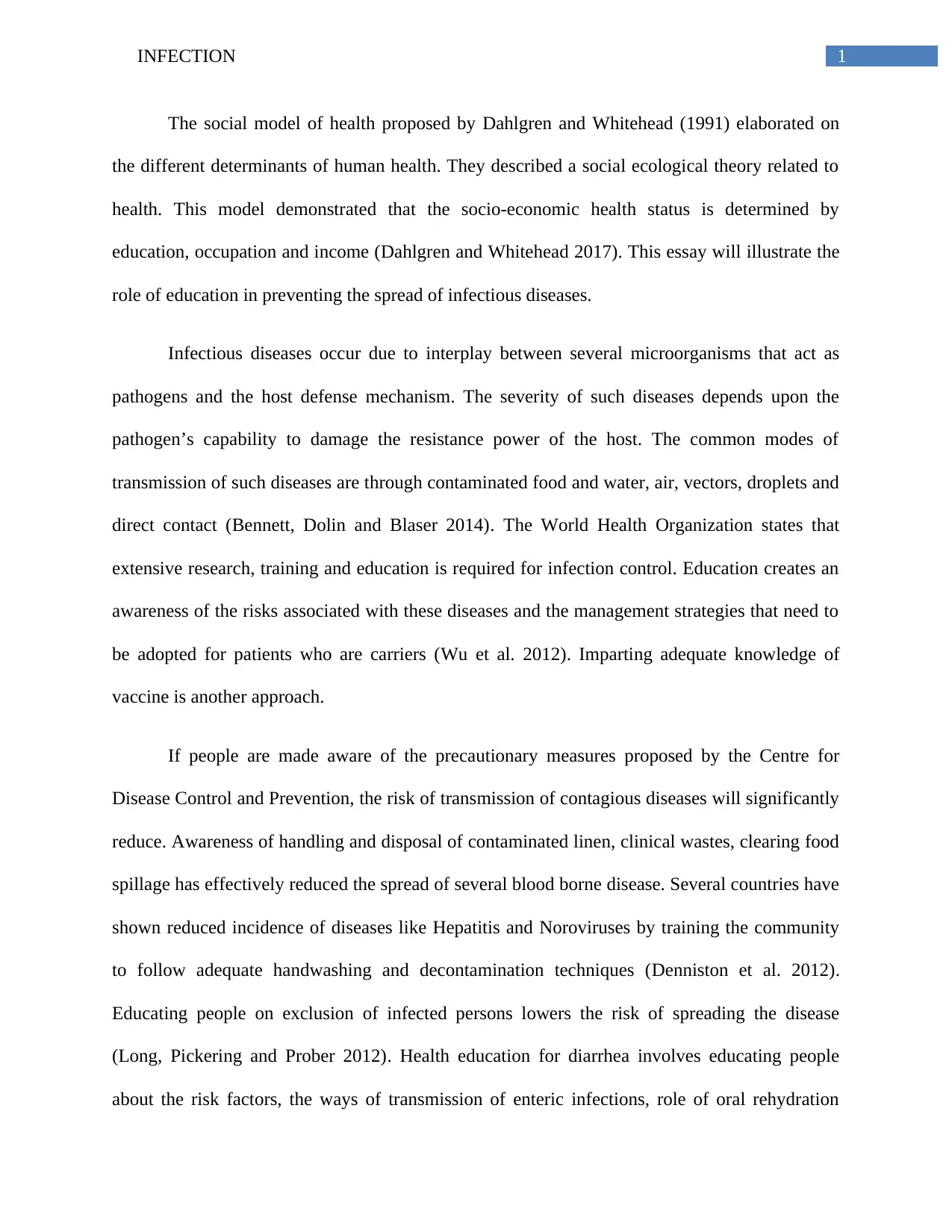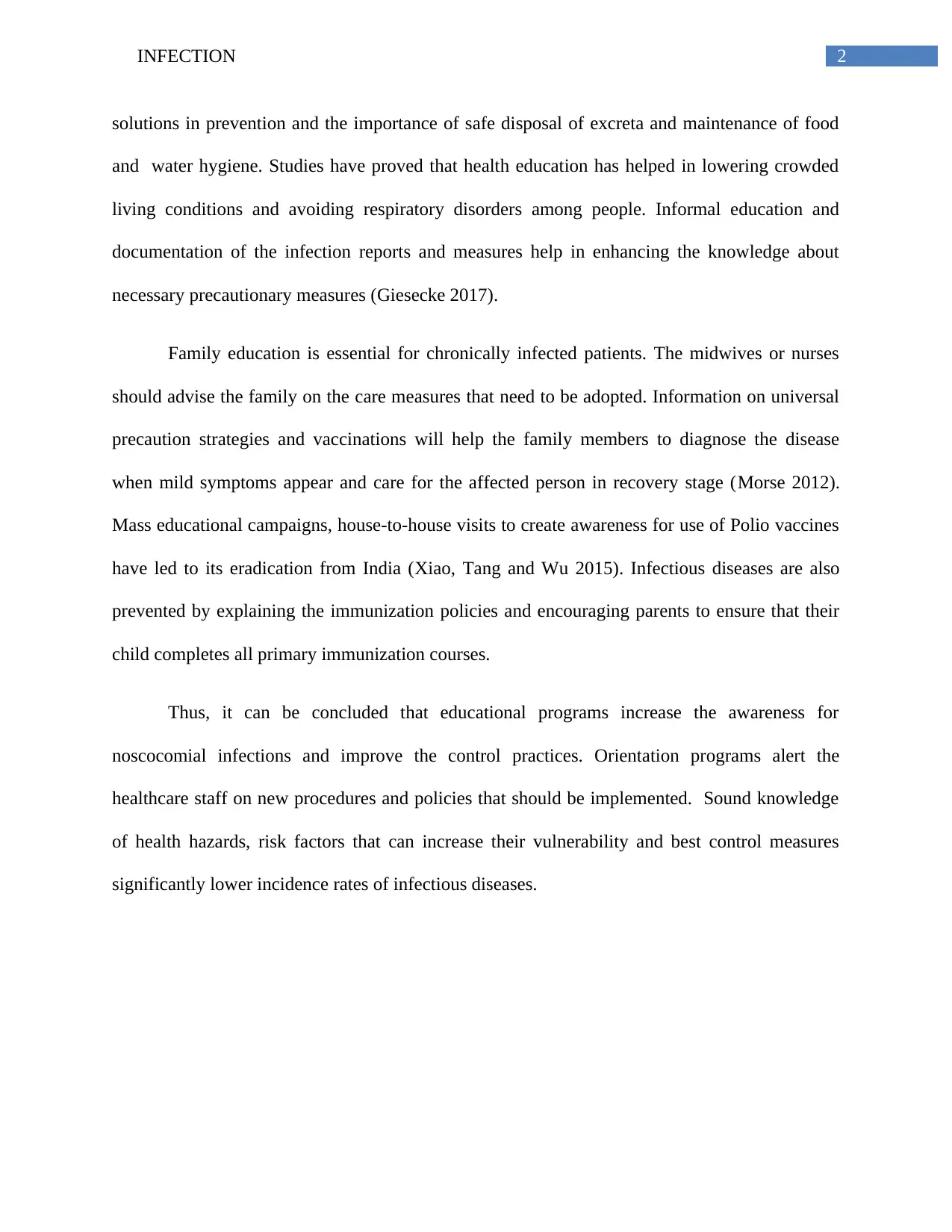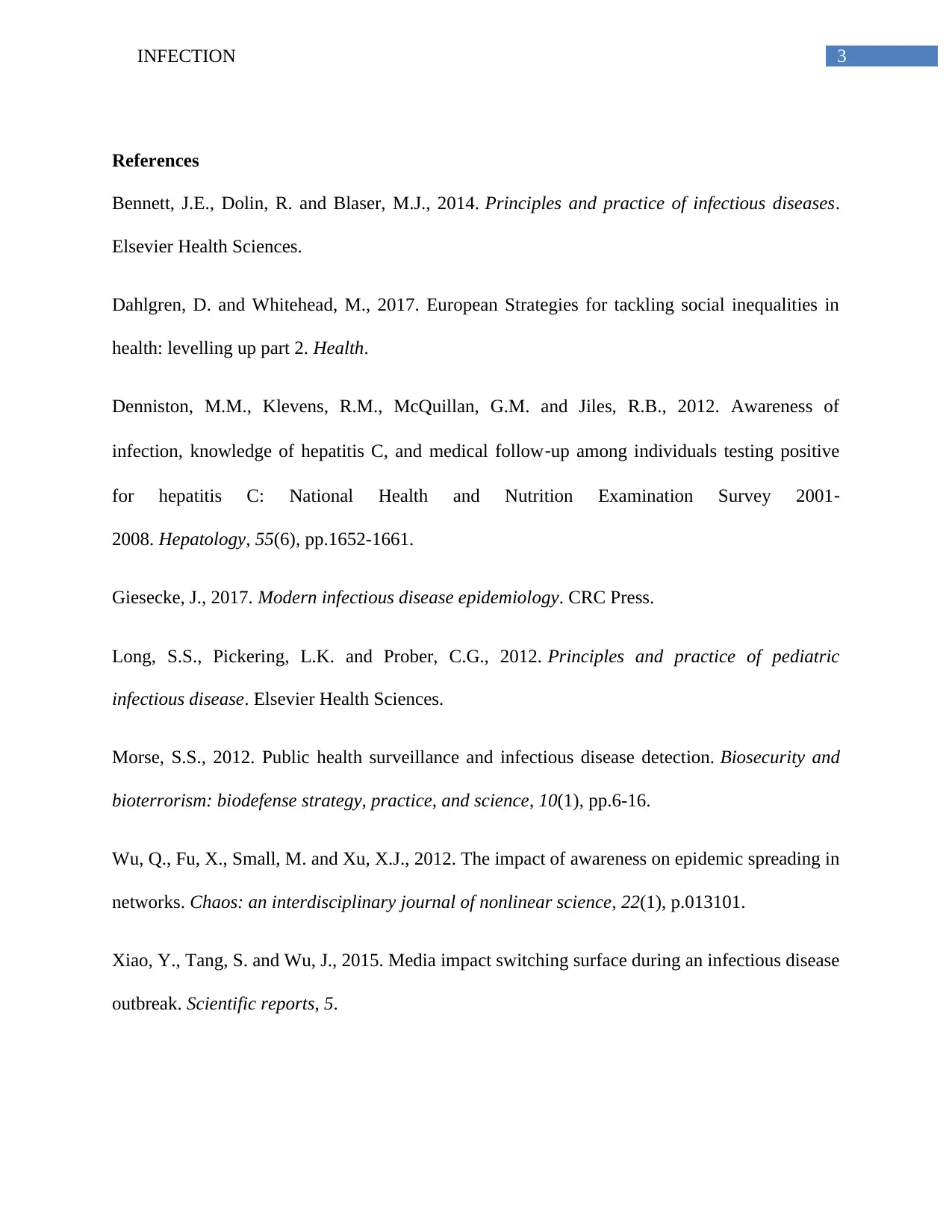Infection Prevention: A Detailed Essay on Education's Key Role
VerifiedAdded on 2020/03/16
|4
|854
|616
Essay
AI Summary
This essay examines the crucial role of education in preventing the spread of infectious diseases. It highlights the social model of health, emphasizing how education, alongside occupation and income, determines health outcomes. The essay details various strategies, including awareness campaigns on risks and management, knowledge of vaccines, proper hygiene practices, and exclusion of infected individuals. It discusses the importance of family education, mass campaigns, and the role of health education in reducing crowded living conditions and respiratory disorders. The essay also points out the value of orientation programs for healthcare staff and the impact of immunization policies, concluding that educational programs significantly enhance infection control practices and lower the incidence of infectious diseases.

Running head: INFECTION
Role of education in preventing infection
Name of the Student
Name of the University
Author Note
Role of education in preventing infection
Name of the Student
Name of the University
Author Note
Paraphrase This Document
Need a fresh take? Get an instant paraphrase of this document with our AI Paraphraser

1INFECTION
The social model of health proposed by Dahlgren and Whitehead (1991) elaborated on
the different determinants of human health. They described a social ecological theory related to
health. This model demonstrated that the socio-economic health status is determined by
education, occupation and income (Dahlgren and Whitehead 2017). This essay will illustrate the
role of education in preventing the spread of infectious diseases.
Infectious diseases occur due to interplay between several microorganisms that act as
pathogens and the host defense mechanism. The severity of such diseases depends upon the
pathogen’s capability to damage the resistance power of the host. The common modes of
transmission of such diseases are through contaminated food and water, air, vectors, droplets and
direct contact (Bennett, Dolin and Blaser 2014). The World Health Organization states that
extensive research, training and education is required for infection control. Education creates an
awareness of the risks associated with these diseases and the management strategies that need to
be adopted for patients who are carriers (Wu et al. 2012). Imparting adequate knowledge of
vaccine is another approach.
If people are made aware of the precautionary measures proposed by the Centre for
Disease Control and Prevention, the risk of transmission of contagious diseases will significantly
reduce. Awareness of handling and disposal of contaminated linen, clinical wastes, clearing food
spillage has effectively reduced the spread of several blood borne disease. Several countries have
shown reduced incidence of diseases like Hepatitis and Noroviruses by training the community
to follow adequate handwashing and decontamination techniques (Denniston et al. 2012).
Educating people on exclusion of infected persons lowers the risk of spreading the disease
(Long, Pickering and Prober 2012). Health education for diarrhea involves educating people
about the risk factors, the ways of transmission of enteric infections, role of oral rehydration
The social model of health proposed by Dahlgren and Whitehead (1991) elaborated on
the different determinants of human health. They described a social ecological theory related to
health. This model demonstrated that the socio-economic health status is determined by
education, occupation and income (Dahlgren and Whitehead 2017). This essay will illustrate the
role of education in preventing the spread of infectious diseases.
Infectious diseases occur due to interplay between several microorganisms that act as
pathogens and the host defense mechanism. The severity of such diseases depends upon the
pathogen’s capability to damage the resistance power of the host. The common modes of
transmission of such diseases are through contaminated food and water, air, vectors, droplets and
direct contact (Bennett, Dolin and Blaser 2014). The World Health Organization states that
extensive research, training and education is required for infection control. Education creates an
awareness of the risks associated with these diseases and the management strategies that need to
be adopted for patients who are carriers (Wu et al. 2012). Imparting adequate knowledge of
vaccine is another approach.
If people are made aware of the precautionary measures proposed by the Centre for
Disease Control and Prevention, the risk of transmission of contagious diseases will significantly
reduce. Awareness of handling and disposal of contaminated linen, clinical wastes, clearing food
spillage has effectively reduced the spread of several blood borne disease. Several countries have
shown reduced incidence of diseases like Hepatitis and Noroviruses by training the community
to follow adequate handwashing and decontamination techniques (Denniston et al. 2012).
Educating people on exclusion of infected persons lowers the risk of spreading the disease
(Long, Pickering and Prober 2012). Health education for diarrhea involves educating people
about the risk factors, the ways of transmission of enteric infections, role of oral rehydration

2INFECTION
solutions in prevention and the importance of safe disposal of excreta and maintenance of food
and water hygiene. Studies have proved that health education has helped in lowering crowded
living conditions and avoiding respiratory disorders among people. Informal education and
documentation of the infection reports and measures help in enhancing the knowledge about
necessary precautionary measures (Giesecke 2017).
Family education is essential for chronically infected patients. The midwives or nurses
should advise the family on the care measures that need to be adopted. Information on universal
precaution strategies and vaccinations will help the family members to diagnose the disease
when mild symptoms appear and care for the affected person in recovery stage (Morse 2012).
Mass educational campaigns, house-to-house visits to create awareness for use of Polio vaccines
have led to its eradication from India (Xiao, Tang and Wu 2015). Infectious diseases are also
prevented by explaining the immunization policies and encouraging parents to ensure that their
child completes all primary immunization courses.
Thus, it can be concluded that educational programs increase the awareness for
noscocomial infections and improve the control practices. Orientation programs alert the
healthcare staff on new procedures and policies that should be implemented. Sound knowledge
of health hazards, risk factors that can increase their vulnerability and best control measures
significantly lower incidence rates of infectious diseases.
solutions in prevention and the importance of safe disposal of excreta and maintenance of food
and water hygiene. Studies have proved that health education has helped in lowering crowded
living conditions and avoiding respiratory disorders among people. Informal education and
documentation of the infection reports and measures help in enhancing the knowledge about
necessary precautionary measures (Giesecke 2017).
Family education is essential for chronically infected patients. The midwives or nurses
should advise the family on the care measures that need to be adopted. Information on universal
precaution strategies and vaccinations will help the family members to diagnose the disease
when mild symptoms appear and care for the affected person in recovery stage (Morse 2012).
Mass educational campaigns, house-to-house visits to create awareness for use of Polio vaccines
have led to its eradication from India (Xiao, Tang and Wu 2015). Infectious diseases are also
prevented by explaining the immunization policies and encouraging parents to ensure that their
child completes all primary immunization courses.
Thus, it can be concluded that educational programs increase the awareness for
noscocomial infections and improve the control practices. Orientation programs alert the
healthcare staff on new procedures and policies that should be implemented. Sound knowledge
of health hazards, risk factors that can increase their vulnerability and best control measures
significantly lower incidence rates of infectious diseases.
⊘ This is a preview!⊘
Do you want full access?
Subscribe today to unlock all pages.

Trusted by 1+ million students worldwide

3INFECTION
References
Bennett, J.E., Dolin, R. and Blaser, M.J., 2014. Principles and practice of infectious diseases.
Elsevier Health Sciences.
Dahlgren, D. and Whitehead, M., 2017. European Strategies for tackling social inequalities in
health: levelling up part 2. Health.
Denniston, M.M., Klevens, R.M., McQuillan, G.M. and Jiles, R.B., 2012. Awareness of
infection, knowledge of hepatitis C, and medical follow‐up among individuals testing positive
for hepatitis C: National Health and Nutrition Examination Survey 2001‐
2008. Hepatology, 55(6), pp.1652-1661.
Giesecke, J., 2017. Modern infectious disease epidemiology. CRC Press.
Long, S.S., Pickering, L.K. and Prober, C.G., 2012. Principles and practice of pediatric
infectious disease. Elsevier Health Sciences.
Morse, S.S., 2012. Public health surveillance and infectious disease detection. Biosecurity and
bioterrorism: biodefense strategy, practice, and science, 10(1), pp.6-16.
Wu, Q., Fu, X., Small, M. and Xu, X.J., 2012. The impact of awareness on epidemic spreading in
networks. Chaos: an interdisciplinary journal of nonlinear science, 22(1), p.013101.
Xiao, Y., Tang, S. and Wu, J., 2015. Media impact switching surface during an infectious disease
outbreak. Scientific reports, 5.
References
Bennett, J.E., Dolin, R. and Blaser, M.J., 2014. Principles and practice of infectious diseases.
Elsevier Health Sciences.
Dahlgren, D. and Whitehead, M., 2017. European Strategies for tackling social inequalities in
health: levelling up part 2. Health.
Denniston, M.M., Klevens, R.M., McQuillan, G.M. and Jiles, R.B., 2012. Awareness of
infection, knowledge of hepatitis C, and medical follow‐up among individuals testing positive
for hepatitis C: National Health and Nutrition Examination Survey 2001‐
2008. Hepatology, 55(6), pp.1652-1661.
Giesecke, J., 2017. Modern infectious disease epidemiology. CRC Press.
Long, S.S., Pickering, L.K. and Prober, C.G., 2012. Principles and practice of pediatric
infectious disease. Elsevier Health Sciences.
Morse, S.S., 2012. Public health surveillance and infectious disease detection. Biosecurity and
bioterrorism: biodefense strategy, practice, and science, 10(1), pp.6-16.
Wu, Q., Fu, X., Small, M. and Xu, X.J., 2012. The impact of awareness on epidemic spreading in
networks. Chaos: an interdisciplinary journal of nonlinear science, 22(1), p.013101.
Xiao, Y., Tang, S. and Wu, J., 2015. Media impact switching surface during an infectious disease
outbreak. Scientific reports, 5.
1 out of 4
Related Documents
Your All-in-One AI-Powered Toolkit for Academic Success.
+13062052269
info@desklib.com
Available 24*7 on WhatsApp / Email
![[object Object]](/_next/static/media/star-bottom.7253800d.svg)
Unlock your academic potential
Copyright © 2020–2025 A2Z Services. All Rights Reserved. Developed and managed by ZUCOL.




